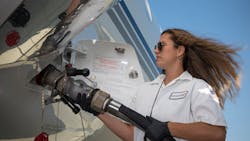It’s no secret the pandemic caused a major disruption in America’s labor force. According to the U.S. Chamber of Commerce, more than 50 million workers quit their jobs in 2022 – many of whom were seeking increased work-life balance, flexibility and compensation.
The latest 2023 data shows there would be 1.95 million more workers today if labor force participation was the same as in February 2020. The current labor force participation rate is 62.6%, which means there are 1.95 million fewer workers in the labor force compared to before the pandemic.
While thousands of people are entering the workforce, there are still over 10 million open jobs. Currently, there are 75 workers for every 100 open jobs in the U.S. This means every state is facing an unprecedented challenge to recruit, hire and retain qualified workers. What does this mean for the general aviation industry?
Across the nation, aircraft mechanics and pilots are retiring faster than they can be replaced. The Aviation Technician Education Council, dedicated to promoting and supporting technician education, reports that an increase in newly certified aircraft mechanics last year did not offset the loss of significant talent during the pandemic. It predicts the aircraft mechanic pipeline in the U.S. will need to increase by at least 20% to meet projected workforce demand.
The aviation industry also continues to struggle with a significant pilot shortage. The U.S. Bureau of Labor Statistics estimates there will be 18,000 openings per year for commercial pilots this decade, with many of those replacing retirees. However, the number of commercial pilot certificates issued by the Federal Aviation Administration totaled only 13,715 in 2022 and 12,771 in 2021 – indicating an ongoing labor shortfall.
Are military veterans transitioning to civilian life the answer to general aviation’s workforce shortage? The latest federal data indicates that of the approximately 9 million veterans employed across the U.S. economy in 2022, 7.6% (about 650,000) were in occupations directly involving transportation.
That occupational choice is a significantly greater share than for the employed non-veteran population, of whom only 5% were involved in transportation occupations. Overall, about one in every 12 veterans chose to work in the transportation sector – helping to support a critical military-to-civilian aviation career pipeline.
Notably, there are fewer people today using the military as a pathway to the cockpit, which has decreased the flow of veterans entering civil and commercial aviation. This makes it more important than ever for airport businesses to cast a wider net and strengthen their efforts to attract and retain new and qualified employees.
While some companies consider aviation experience a prerequisite, it is equally important to consider how military experience enables veterans to develop the skills, leadership, discipline and teamwork needed to join the airport’s diverse workforce, on the ground or in the air.
Airport employers should not limit their search to pilots or aircraft maintenance technicians. Hiring transitioning service members for successful careers as aircraft mechanics, avionics and line service technicians, customer service representatives and other airport occupations is critical for the future success of the global business aviation industry.
Businesses that hire veterans have a valuable opportunity to hire individuals who can learn quickly, think independently, adapt to a rapidly changing environment and provide exceptional customer service. Many of the standards and processes learned in the military also transfer well to the civilian aviation industry.
In addition, one of the most valuable qualifications that a transitioning service member can offer a prospective employer is active security clearance. Veterans have a significant advantage over noncleared candidates because the security clearance process is a typically long and expensive process – taking months or even years to complete.
It is also important for airport businesses to know that competition for military talent extends beyond general aviation to other industries that value veterans’ unique skill sets and abilities. As a result, aviation and non-aviation related businesses alike are utilizing military transition programs and incentives to attract candidates.
Some companies are even networking with military bases to connect service members with employers during their last 180 days of service for on-the-job training, apprenticeships and internships. The Department of Defense’s SkillBridge program allows service members to gain valuable civilian work experience – connecting them with industry partners in real-world job experiences.
For participating industry partners and businesses, SkillBridge is an opportunity to access and leverage the world’s most highly trained and motivated workforce at no cost. Participating service members receive their military compensation and benefits, while industry partners and businesses provide the training and work experience.
In today’s competitive market, what can airport businesses do to recruit veterans who are transitioning to the civilian workforce?
First, employers must be prepared to explain their company’s benefits – such as medical coverage, flexible work schedules, retirement and employee assistance programs – in terms that those who are transitioning from active-duty military service can easily understand. The Society for Human Resource Development also offers these tips:
· Create a welcoming environment, such as arranging for a job candidate to meet with other veterans who are part of your team
· Train human resources and hiring managers to understand military resumes, job titles and language
· Visit local military bases and partner with military assistance groups
· Provide training for service members on how to apply their skills and abilities to civilian jobs
· Create a veterans employee resource group
· Offer a peer advisor to assist veterans with transitioning to the civilian workplace
· Include and recruit military spouses
Airport businesses also should find creative ways to recognize and support veterans in the community. For example, Van Nuys Airport, located in Los Angeles’ competitive job market, recently launched a virtual VNY Veterans Honor Wall (www.vnyhonorwall.com) to recognize employee veterans for their
sacrifice and service. In addition to fostering positive employee engagement, the website serves as a tool for recruiting top talent and educating the community about the airport’s diverse workforce.
Finally, it is important to show transitioning service members how their skills, abilities and values translate into their new roles in business aviation. Many veterans are seeking employment with companies that represent their core values. Those who have served our country in uniform are especially attracted to organizations with a culture of integrity, teamwork, leadership and ability to achieve.




